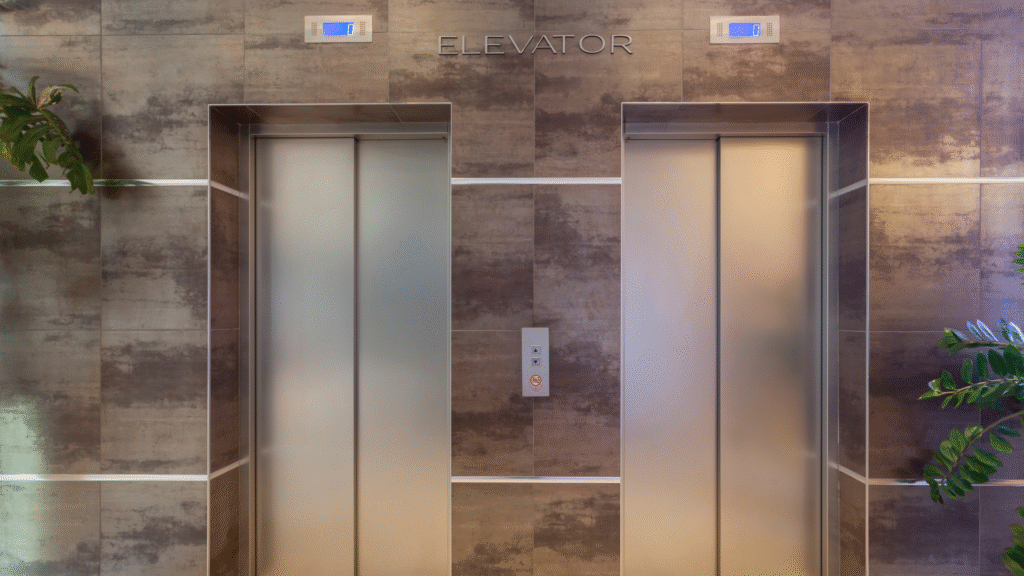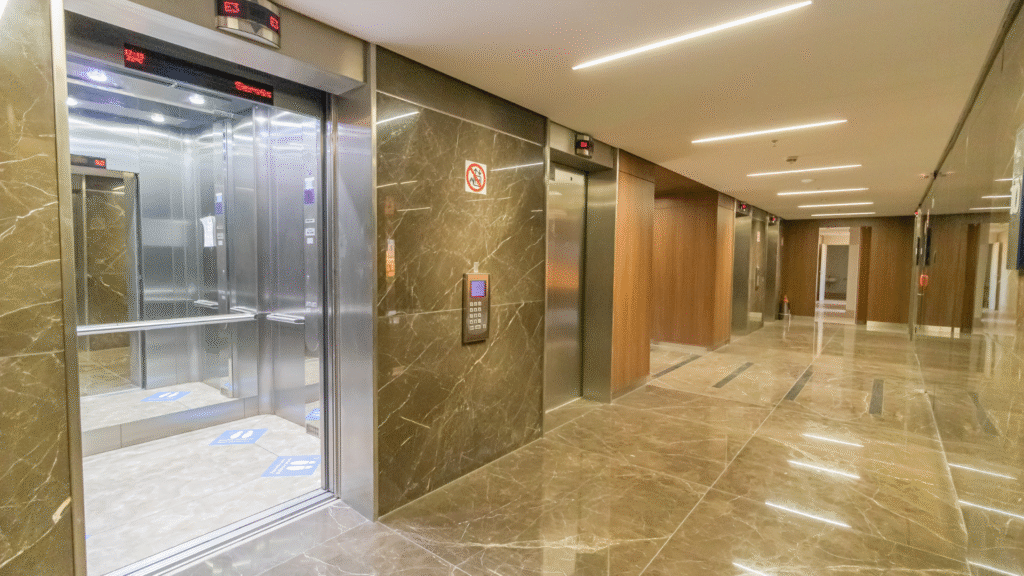Elevator cabs may be small, but when it comes to fire safety, they are among the most critical spaces in any commercial or residential building. These enclosed, high-traffic areas demand materials that do more than look good, they must meet stringent fire safety codes to protect lives and property.
Despite this, many elevator upgrades still involve materials that aren’t fire-rated or certified for enclosed spaces. In this article, we’ll explain what Class A fire-rated materials are, why UL 10B and 10C testing is important, and how Elevator Refresh helps you meet safety standards without compromising on design.
Understanding Fire Safety in Enclosed Vertical Spaces
Elevators are considered vertical shafts in the context of fire safety codes. In the event of a fire, these shafts can act like chimneys, rapidly moving smoke and heat between floors. This is why elevator interiors are strictly regulated by fire codes, and why the finishes inside them must resist both flame spread and smoke development.
Unlike a typical office or hotel hallway, an elevator cab is a confined space with minimal ventilation. In the event of a fire, occupants may be trapped inside, making flame-resistant materials essential to prevent flashover and smoke inhalation.

What Does “Class A Fire Rating” Actually Mean?
In North America, interior finish materials are typically classified into three categories: Class A, B, or C. These ratings are determined based on flame spread and smoke development according to ASTM E84 standards.
- Class A: Flame spread index of 0-25; smoke developed index of 0-450
- Class B: Flame spread index of 26-75
- Class C: Flame spread index of 76-200
Class A materials are considered the safest for interior use in confined and high-occupancy spaces such as lobbies, stairwells, and elevator cabs. They significantly reduce the chance of flames spreading rapidly.
Elevator Refresh uses certified Class A fire-rated materials. This ensures that our elevator wraps not only meet building codes, but also contribute to safer environments in case of emergencies.
UL 10B and 10C Testing: Why It Matters

In addition to flame spread ratings, UL 10B and UL 10C are standards specifically designed to test the fire endurance of building materials, particularly for use in fire doors and vertical enclosures.
- UL 10B: Measures the performance of materials in standard fire exposure tests
- UL 10C: Adds requirements for positive pressure fire testing (a more rigorous and realistic simulation of fire conditions)
When a material passes these tests, it means it can withstand direct exposure to flame for a specified period, helping contain the spread of fire and smoke. This is especially critical for elevator interiors, which are often connected to lobbies, corridors, and escape routes.In addition to flame spread ratings, UL 10B and UL 10C are standards specifically designed to test the fire endurance of building materials, particularly for use in fire doors and vertical enclosures.
- UL 10B: Measures the performance of materials in standard fire exposure tests
- UL 10C: Adds requirements for positive pressure fire testing (a more rigorous and realistic simulation of fire conditions)
When a material passes these tests, it means it can withstand direct exposure to flame for a specified period, helping contain the spread of fire and smoke. This is especially critical for elevator interiors, which are often connected to lobbies, corridors, and escape routes.
Using UL-tested materials isn’t just about compliance; it’s about liability protection, risk mitigation, and most importantly, saving lives.
Consequences of Using Non-Compliant Materials
Unfortunately, many elevator upgrades are done with aesthetics in mind, using decorative wall panels, wallpaper, or low-cost laminates that may look good but don’t meet code.
Here’s what can go wrong:
- Failed inspections and retrofitting costs
- Insurance coverage issues in case of fire
- Legal liability if injuries or fatalities occur due to non-compliant materials
- Increased fire spread risk, especially in multi-story buildings
Even if a material looks safe, it must have documented test results and certifications to be considered code-compliant.
Elevator Refresh: Combining Fire Safety with Design Flexibility

Safety shouldn’t mean sacrificing design. That’s why we work with architectural films that combine:
- Class A fire-rating
- UL 10B and 10C certification
- 450+ design options (woodgrains, metals, stone, fabric, leather, and more)
- High durability for high-traffic environments
- Fast, no-demolition installation
Our clients include property managers, hospitality operators, and general contractors who want both aesthetics and performance, without the delays, costs, and mess of traditional renovation
Questions to Ask Before Your Next Elevator Renovation
- Are the materials Class A fire-rated?
- Can they provide UL 10B/10C test reports?
- Are they approved for elevator interiors?
- How long does installation take?
- Will you need to shut down the elevator?
- If the answer to any of these is uncertain, it’s time to consider a safer alternative.
Conclusion: Choose Materials That Do More Than Look Good
Elevators might seem like a small detail in the grand scheme of a building’s interior. But in the event of an emergency, that detail becomes a matter of life and death.
Choosing Class A fire-rated, UL-tested materials is more than a checkbox for compliance, it’s a commitment to protecting everyone who uses your space.
At Elevator Refresh, we believe great design should always be safe, fast, and code-compliant. Contact us to learn more about our fire-rated finishes, or request a sample to see the possibilities for your building.
